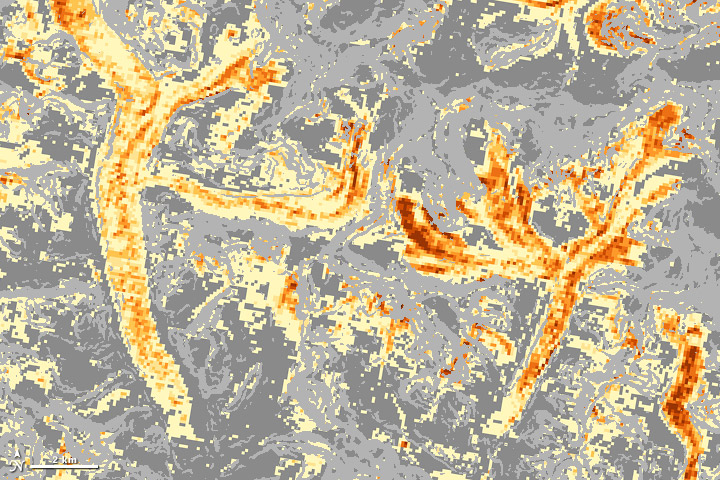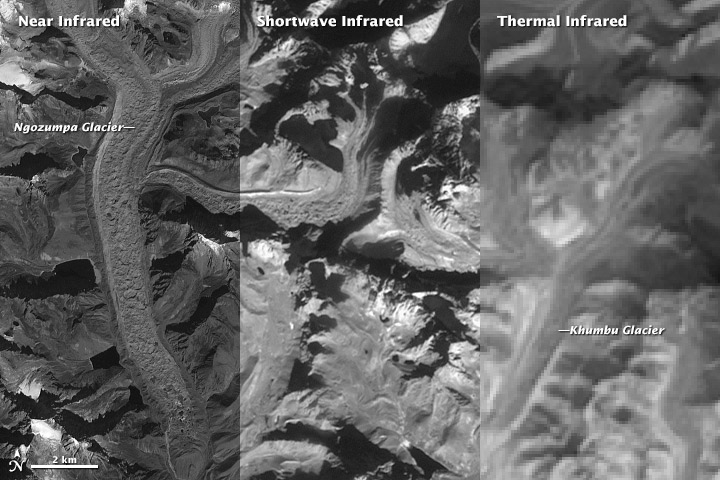
acquired November 29, 2005

near infrared
acquired November 29, 2005
download large near infrared image (1 MB, JPEG, 2486x2378)
acquired November 29, 2005
download large shortwave infrared image (1 MB, JPEG, 2486x2378)
acquired November 29, 2005
download large thermal infrared image (930 KB, JPEG, 2486x2378)
While the human eye perceives only a narrow portion of the electromagnetic spectrum,
satellite instruments can sense a much broader range of wavelengths.
Many sensors are tuned to be sensitive to specific parts or bands of the
spectrum—such as the infrared—that are invisible to human eyes.
The Advanced Spaceborne Thermal Emission and Reflection Radiometer
(ASTER) instrument—built by Japan’s Ministry of Economy, Trade, and
Industry for NASA’s Terra satellite—observes six bands in the shortwave
infrared (just beyond red light at 1.0 to 2.5 microns) and five in the
thermal infrared (3 to 12 microns). The Enhanced Thematic Mapper Plus
(ETM+) and Operational Land Imager (OLI) on Landsats 7 and 8 also have
bands in the shortwave and thermal infrared. (See this page for a graphic showing the location of ASTER’s bands.)
The bottom image above shows how Khumbu and Ngozumpa glaciers—both in Nepal, near Mount Everest—appear
to ASTER in three different spectral bands. The near-infrared band
appears crisper than the others because ASTER has the highest spatial resolution
at that band. ASTER’s resolution is 15 meters per pixel in the
near-infrared, 30 meters per pixel in the shortwave infrared, and 90
meters per pixel in the thermal infrared.
NASA scientist Kimberly Casey
has mined data from numerous spectral bands to generate maps of debris
on key glaciers around the world. Her maps not only discriminate
between dirty and clean ice; they describe the composition of the
debris. This is important because the type of debris can affect the
melting rate of glacial ice and can influence how it responds to climate change.
The ability to observe different wavelengths is critical because
different types of debris—rocks from landslides, volcanic ash, airborne
dust, or polluting soot—leave unique “spectral fingerprints” that
satellites can measure. By analyzing the ASTER data above, for instance,
Casey mapped the silica content of glacial debris on Khumbu and
Ngozumpa.
In the top image, rock debris with higher silica content (granite) is shown in shades of orange and red, while debris with less silica (gneiss)
is shades of yellow. While both glaciers contain silica-rich debris,
Casey’s map shows that Khumbu glacier has much more distinct bands.
Silica-rich rocks tends to absorb less sunlight than debris shed by
darker debris rich with amphibolite and basalt that Casey analyzed on other glaciers as part of her project.
In addition, Casey thinks that silica maps of glacial debris will
prove useful for monitoring the speed that glaciers flow and for
identifying weathering processes affecting surface debris. To learn more
about Casey’s research, read our new feature: “Painted Glaciers.”
References
- Casey, K. et al (2012, January 19) Geochemical characterization of glacier debris via in situ and optical remote sensing methods: a case study in the Khumbu Himalaya, Nepal. The Cryosphere, 6, 85-100.
- Casey, K. (2012) Supraglacial dust and debris: geochemical comparisons from glaciers in Svalbard, southern Norway, Nepal and New Zealand. Earth System Science Data Discussions, 5, 107-145.
- Casey, K. and Kääb, A. (2012, September 7) Estimation of Supraglacial Dust and Debris Geochemical Composition via Satellite Reflectance and Emissivity. Remote Sensing, 4 (9), 2554-2575.
NASA images by Robert Simmon, using ASTER data. Caption by Adam Voiland.
- Instrument:
- Terra - ASTER
Ricardo M Marcenaro - Facebook
Blogs in operation of The Solitary Dog:
Solitary Dog Sculptor:
byricardomarcenaro.blogspot
Solitary Dog Sculptor I:
byricardomarcenaroi.blogspot.com
Para:
comunicarse conmigo,
enviar materiales para publicar,
propuestas comerciales:
marcenaroescultor@gmail.com
For:
contact me,
submit materials for publication,
commercial proposals:
marcenaroescultor@gmail.com
My blogs are an open house to all cultures, religions and countries. Be a follower if you like it, with this action you are building a new culture of tolerance, open mind and heart for peace, love and human respect.
Thanks :)
Mis blogs son una casa abierta a todas las culturas, religiones y países. Se un seguidor si quieres, con esta acción usted está construyendo una nueva cultura de la tolerancia, la mente y el corazón abiertos para la paz, el amor y el respeto humano.
Mis blogs son una casa abierta a todas las culturas, religiones y países. Se un seguidor si quieres, con esta acción usted está construyendo una nueva cultura de la tolerancia, la mente y el corazón abiertos para la paz, el amor y el respeto humano.
Gracias:)

No hay comentarios:
Publicar un comentario